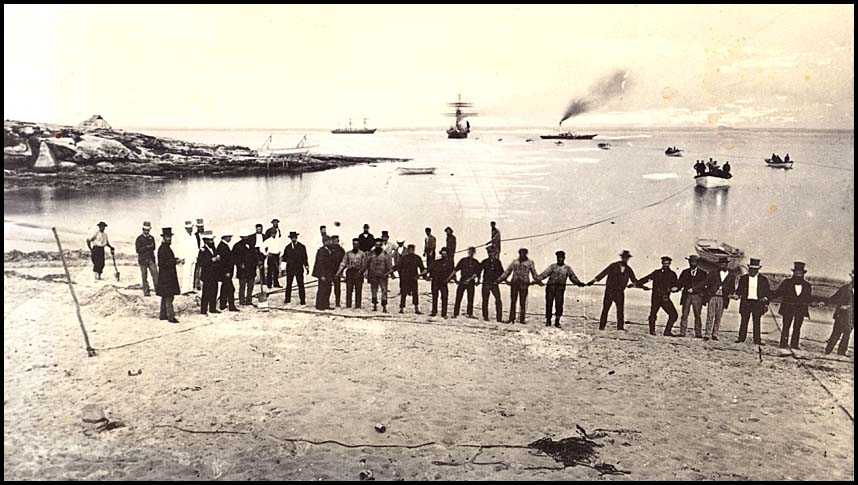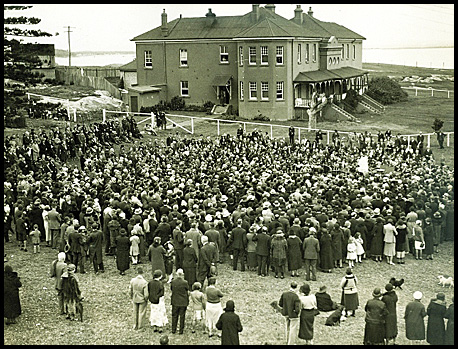The Australia - New Zealand cable: 1876.
- Australia 1901-1988
- New South Wales
- Overview of NSW
- Telegraph lines
- Telegraph Offices
- Date stamps
- Forms
- Envelopes
- Instructional annotation
- Collect
- Delayed
- Free
- Immediate Urgent
- Reply paid
- Rates
- Stamps
- 1871 Telegraph stamps
- 1885 proposal
- 1893 proposal
- Queensland
- South Australia
- Tasmania
- Victoria
- Western Australia
- International
- Special aspects
The following descriptions are covered on this page.
- The first ideas about an Australia-New Zealand cable;
- The laying of the Australia-New Zealand cable;
- Management and operation of the cable
- Reports related to the construction of the Cable.
1. The first ideas about an Australian-New Zealand cable.
The first discussions about the possibility of a cable linking Australia and New Zealand were held even before the first telegraph line had been constructed in New Zealand. For example, the Goulburn Herald of 6 November 1858 reported that:
"The subject of uniting New Zealand with Australia, by a submarine telegraph cable, has been mooted and its practicability has been reported upon by Mr. McGowan, Superintendent of the Telegraph Department in Victoria. Wellington is recognised as the most convenient point for communicating with New Zealand. The cost is estimated at £180,000. Supposing the Panama route be established, the formation of a telegraph to New Zealand would enable news to be transmitted to Australia a week in advance of the mail".
In April 1873, a Report titled Telegraph Cables was published by the New South Wales Government concerning details about cables:
- between New South Wales and New Zealand; and
- between Queensland (Normanton) and Singapore.
In part, this Report recomended that "the cost per message of 20 words, from New Zealand to New South Wales, not to exceed 15 shillings; the charges for each word above 20 being 9d".
After many discussions of the cable possibility, the South Australian Advertiser on 10 October 1873 reported that "A private London telegram states that the Eastern Extension Company are considering proposals for laying a cable from Queensland to New Zealand, and hope soon to make a satisfactory offer".
Soon after, the Sydney Morning Herald of 13 October 1873:
"The telegram announcing that the Eastern Extension Company is giving its serious consideration to a proposal for constructing and laying the two new cables which are to connect New Zealand with Australia and Queensland with Asia is so far satisfactory that it seems to indicate that no difficulty will be found in getting the work executed when all the preliminary negotiations for the guarantee are completed. So far however, as this colony is concerned, the announcement is a little in advance of our own action for the Legislature has not yet sanctioned the proposal agreed to at the time of the (Inter-Colonial) Conference that the three eastern colonies should join in the guarantee. It so happens that, both in Queensland and in New Zealand, the meetings of the Parliaments have taken place earlier than with us. In both those colonies, the agreement has been submitted for approval and been ratified and it only awaits a similar ratification with us to be pushed forward at once into the stage of a contract with the manufacturers".
In December 1875, the NSW Government proposed to appropriate £2,500 from the loan to connect the shore end of the New Zealand cable with Sydney Station and to construct buildings at the cable landing.
2. The laying of the Australia-New Zealand cable.
A very complete description of the cable ship Hibernia and the plans for laying the Australia-New Zealand cable is included in the Sydney Morning Herald of 3 February 1876.
On 1 January 1876, the South Australian Register reported that "the Edinburgh, a vessel in the employ of the Telegraph Construction and Maintenance Company, has arrived with 45 miles of cable for South Australia and 204 miles for the New Zealand telegraph". The cable was laid by the cable ships Hibernia and Edinburgh. The Hibernia laid the cable from Frenchmans Beach in La Perouse, Sydney to about 60 miles from Cable Bay. On or about 15 February 1876, many newspapers reported news like the Avoca Mail:
"A telegraphic message was received on Saturday (12 February) from the Hibernia, the steamer engaged in laying the New Zealand cable, stating that, having got to within 100 miles of Nelson, N.Z., it had been found necessary to buoy the cable and suspend operations in consequence of heavy weather. As soon as the weather moderates, the work, which has been very satisfactorily carried on so far, will be resumed and in all probability telegraphic communication with New Zealand will be etablished in a day or two".
The Edinburgh completed the laying to where it came ashore at Cable Bay, Nelson. On Monday 21 February, 1876, the submarine cable was opened for traffic between Australia and New Zealand.
On 23 February 1876, The Argus reported:
"Telegraphic communication with New Zealand has been successfully established. The New South Wales end of the cable was laid at Botany Bay on Saturday, February 5, and the Hibernia and Edinburgh, the two steamers engaged in laying the submarine cable, then proceeded on their voyage to New Zealand. The work was performed in a very expeditious and successful manner the whole work being completed within a fortnight. The New Zealand end of the cable was landed at Nelson. On the completion of the work, congratulatory messages passed between the Governor of New Zealand and the Governors of the various Australian colonies.
The charge for sending messages from Melbourne to New Zealand is 10s 6d. for 10 words, and 1s. for every additional word".
 The start of laying the cable to New Zealand from Frenchman's Beach, La Perouse in Sydney in 1876. The cable was suspended from the buoys coming from the stern of the C.S. Hibernia. |
3. The management and operation of the cable.
The cable was laid, owned and managed by the Eastern Extension Australasia and China Telegraph Company Ltd. It had been expected to last 10 years but it actually remained in service for 41 years.
The earliest cable sent from New Zealand to one of the Australian Colonies was from Napier on 28 November 1877 - see SC-DO-5A. The route for its transmission is unclear. From Napier it arrived in Adelaide - possibly to be sent over the Telegraph line to England for delivery at Eccles in the County of LancashireEccles is of course famous for its Eccles cakes which were banned by Oliver Cromwell in 1650 in the belief that the cakes - and the wakes - had Pagan connections. . The form has however clear instructions about being posted - not telegraphed. A post charge of £1 3s 6d is shown together with a manuscript note "ADELAIDE POST VIA BRINDISI". That delivery would have taken about two months - a long time for a message saying "Dont be depressed...". Using Adelaide may have been a quick connection to the steamer returning to Emgland.
The cable consisted of five miles of 14 tons/mile shore end, 12 miles of first intermediate cable of 4 tons/mile, another intermediate cable, then the deep sea cable of 35 cwt/mile.
The Adelaide Observer of 26 February 1876 commented as follows:
"Our Sydney telegrams advise us of the completion of the New Zealand cable and refer to the congratulatory messages exchanged by the Governors of New South Wales and New Zealand on the occasion. We only want the Western Australian line, now in course of construction, to establish wire communication between the great provinces of Australasia.
A notice at the Adelaide Post Office announces the laying of the cable and states that the rate charged for messages from South Australia will be 10s. 6d. for ten words, the address being reckoned as part of the message, and 1s. for every additional word.
The following telegrams were exchanged between Sir Julius Vogel, K.C.M.G., the Premier of New Zealand, and the Hon. J. P. Boucaut, Q.C., Premier of this Colony, on Monday, February 21. From Sir Julius Vogel: "We are very glad in New Zealand to be connected by telegraph with South Australia, and, through her transcontinental system, with the rest of the world." From Mr. Boucaut: "We reciprocate the sentiments expressed in your telegram and are proud that our transcontinental line enables you to join the rest of the world. We wish your colony success and look forward to a great dominion of Australasia of which we hope our telegraphic union is typical."
Cable rates from Queensland stations to any part of New Zealand were the same - half a guinea (10s 6d) for 10 words and 1s for each additional word - address and signature counted as part of the message.
In 1882, the Eastern Extension Company completed the construction of the Cable Station building at La Perouse. That enabled the temporary wooden huts to be replaced. The building was designed by the Colonial Architect James Barnett.
In April 1900, the N.Z. Postmaster-General declined to give a renewal of the guarantee to the Eastern Extension Company in connection with the working of the New Zealand-Australian cable.
By 1903, the telegraph service was transferred to a new location in nearby Yarra Bay House - near the grave of the Father Reçeveur.The French priest had arrived in Botany Bay with the Laperouse expedition on 26th January, 1788. He died there three weeks later on 17th February, 1788 and was buried on Laperouse headland.
Although the circumstances of Pére Reçeveur’s death remain somewhat obscure, it has been assumed that he succumbed to wounds received in the confrontation with natives at Tutuila, Samoa on 11th December, 1787 when Captain de Langle and eleven members of the Laperouse expedition were brutally massacred.
 The Electric Telegraph Officer’s Camp: Laying the cable to New Zealand at La Perouse, Botany Bay in 1876. Courtesy the State Library of New South Wales. |
 Picture taken in 1933 when a new grave was established for Father Reçeveur. The Eastern Extension buildings are in the background with Botany Bay behind. |
The Cable Station was used by AWA for telecommunications, training and accommodation until 1917.
In New Zealand, the Cable Bay link was re-routed to Titahi Bay in 1917 then linked to the Eastern Extension Company’s offices in central Wellington by an underground cable. The entire staff from Cable Bay were relocated to Wellington overnight on 22 August, 1917. The cable station land was sold by the Crown in 1919.
Other cables laid to New Zealand were:
- in 1901: the Pacific Cable Board cable from Norfolk Island;
- in 1912: a Sydney-Auckland cable.
Reports about the concept and construction of the New Zealand cable.
- 1875 - Construction of the Telegraphic Cable between New Zealand and New South Wales and between Normanton and Singapore (Papers and Correspondence respecting - March 1874 to April 1875).
- 1875 - Construction of the Telegraphic Cable between New Zealand and New South Wales and between Normanton and Singapore (Papers and Correspondence respecting - March to May 1875).
Both Reports printed by both Houses of Parliament, Queensland.